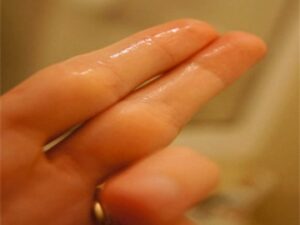The cervix is the narrow, canal-like part of the uterus that lies between the uterus and the vagina. When a woman gives birth, the cervix dilates (expands) to allow the baby to pass through. Nature has bestowed the cervix with protective qualities that help prevent foreign particles from entering the uterine cavity. The cervical glands produce a semi-liquid substance or mucus which acts as a protective obstruction, restricting the entry of infection-causing organisms into a woman’s delicate reproductive system.
Moreover, the mucus also acts as a storehouse that holds the sperm that manage to pass through the vagina’s acidic environment. The mucus holds the sperm for a few days after intercourse, from where they gradually release into the uterine cavity to reach the egg.
Cervical mucus changes in thickness during a woman’s monthly cycle. At the time of ovulation, the cervix produces large amounts of watery mucus to make it easier for sperm to swim through if sexual contact occurs. Once ovulation has occurred and the body is not producing as much estrogen, the mucus turns thick and sticky. The sperm that do make it through to the cervix (about 1 in 2000), can survive in the mucus for several days.
The physiology of the cervical mucus has a direct influence on the ability of the woman to conceive. EWCM or egg-white cervical mucus or is a term used by some fertility doctors and patients to describe the most fertile cervical mucus. EWCM usually appears one or two days before ovulation and looks like the white of a raw egg.
In about 5 to10% of fertile women, the mucus can become hostile or unfriendly, resulting in damage or death of sperm. In case there are very few or no sperm reaching the egg, or when the sperm are damaged, pregnancy cannot occur.
Cervical mucus hostility occurs when:
- the mucus is so thick and sticky that it won’t allow the sperm to pass through
- is too less in quantity, restricting free movement of sperm
- is too acidic for the sperm to survive
- has antibodies that attack and destroy the sperm, mistaking them to be foreign invaders.
As a result of any of the above conditions, a majority or all of the sperm present in the semen are destroyed before they can make it through the cervix to the egg waiting to be fertilized.
How is cervical mucus hostility diagnosed and treated?
The cervical mucus hostility presents no symptoms. If your doctor suspects that cervical hostility may be causing your infertility, they would perform a test known as the post-coital test or PCT.
PCT is a test done a few hours after intercourse where a sample of the cervical mucus is examined under a microscope for the presence of live sperm swimming in a straight line. This indicates that the chemical composition of the mucus is just right for sperm survival. If dead or slow moving sperm are found, it may indicate that the mucus is hostile. For some patients, the doctor may need to do the PCT more than once, as a single negative PCT result may not be a reliable indicator of the underlying problem.
If you or your partner is diagnosed with an infection which may be causing the sperm to die, your doctor would first treat the infection with antibiotics.
If antis perm antibodies are found in the female partner, the following treatment methods are offered:
- IUI or IVF (read more below)
- Use of condom during sexual contact for several months, as it may naturally reduce the level of antibodies. This is however a time-consuming alternative many couples do not like to opt for. Also, this therapy will not work if it’s the male partner who is producing antibodies to his own sperm.
- Estrogen therapy to improve the quality of the mucus. It refers to the administration of estrogen hormone to a woman and the therapy stimulates the mucus secretion
- Steroid therapy is used by some doctors, although at Gaudium we never recommend the use of steroids because of the associated side effects.
I have a hostile cervix. Can I still get pregnant?
Yes, you can!
If you’ve been diagnosed with a hostile cervix, your fertility doctor may recommend the assisted reproductive technique called IUI (intrauterine insemination). It is a simple fertility treatment where selected motile (good quality) sperm are placed directly into the uterine cavity using a thin tube, thus bypassing the hostile cervix.
IUI has been seen as a cost-effective and time-saving fertility treatment for women with cervical mucus hostility. This is because, compared to condom usage, hormone therapy and other treatment alternatives, your doctor has more control over the outcomes of IUI.
At Gaudium, we advise patients to go for IUI if cervical hostility is the only factor causing infertility. If there are other factors present, for example if the male partner has low or nil sperm count, your doctor may recommend IVF or ICSI after a thorough reproductive analysis of both partners.
Have further questions regarding cervical disease? Seeking a second expert opinion before starting your fertility treatment?
Dr. Manika Khanna, India’s leading & award-winning fertility super specialist would be glad to help.




